Racial and Ethnic Disparities in Teleworking Due to the COVID-19 Pandemic in the United States: A Mediation Analysis
Abstract
:1. Introduction
2. Materials and Methods
2.1. Data and Variables
2.2. Mediation Analysis
3. Results
4. Discussion
5. Conclusions
Funding
Institutional Review Board Statement
Informed Consent Statement
Data Availability Statement
Acknowledgments
Conflicts of Interest
References
- Davenport, T.H.; Pearlson, K. Two cheers for the virtual office. MIT Sloan Manag. Rev. 1998, 39, 51. [Google Scholar]
- Baruch, Y. The status of research on teleworking and an agenda for future research. Int. J. Manag. Rev. 2001, 3, 113–129. [Google Scholar] [CrossRef]
- Fairweather, N.B. Surveillance in employment: The case of teleworking. J. Bus. Ethics 1999, 22, 39–49. [Google Scholar] [CrossRef]
- Bentley, T. How Can Organisations Realise the Positive Benefits of Anywhere Working. Hum. Resour. 2014. Available online: https://brainmass.com/file/1567049/Telework+%233.pdf (accessed on 15 September 2021).
- Baruch, Y.; Nicholson, N. Home, sweet work: Requirements for effective home working. J. Gen. Manag. 1997, 23, 15–30. [Google Scholar] [CrossRef]
- Belzunegui-Eraso, A.; Erro-Garcés, A. Teleworking in the Context of the COVID-19 Crisis. Sustainability 2020, 12, 3662. [Google Scholar] [CrossRef]
- Tokarchuk, O.; Gabriele, R.; Neglia, G. Teleworking during the COVID-19 crisis in Italy: Evidence and tentative interpretations. Sustainability 2021, 13, 2147. [Google Scholar] [CrossRef]
- Vasic, M. Challenges of teleworking during the COVID-19 pandemic. Anal. Ekon. Fak. U Subotici 2020, 56, 63–79. [Google Scholar] [CrossRef]
- Chiru, C. Teleworking: Evolution and Trends in USA, EU and Romania. Econ. Manag. Financ. Mark. 2017, 12, 222–229. [Google Scholar]
- Milasi, S.; González-Vázquez, I.; Fernández-Macías, E. Telework before the COVID-19 Pandemic: Trends and Drivers of Differences Across the EU. 2021. Available online: https://doi.org/10.1787/24139424 (accessed on 18 September 2021).
- Hotopp, U. Teleworking in the UK. Labour Mark. Trends 2002, 110, 311–318. [Google Scholar]
- O’Neill, T.A.; Hambley, L.A.; Greidanus, N.S.; MacDonnell, R.; Kline, T.J. Predicting teleworker success: An exploration of personality, motivational, situational, and job characteristics. New Technol. Work Employ. 2009, 24, 144–162. [Google Scholar] [CrossRef]
- Montreuil, S.; Lippel, K. Telework and occupational health: A Quebec empirical study and regulatory implications. Saf. Sci. 2003, 41, 339–358. [Google Scholar] [CrossRef]
- O’Sullivan, G.; Student, M. Literature Review: Teleworking in Human Services. S. Area Consort. Hum. Serv. 2013, 1–42. Available online: https://theacademy.sdsu.edu/wp-content/uploads/2015/02/SACHS_Literature_Review_Telework_Report_2_2013.pdf (accessed on 20 September 2021).
- Silva, -C.A. The attitude of managers toward telework, why is it so difficult to adopt it in organizations? Technol. Soc. 2019, 59, 101133. [Google Scholar] [CrossRef]
- Novianti, K.R.; Roz, K. Teleworking and Workload Balance on Job Satisfaction: Indonesian Public Sector Workers during COVID-19 Pandemic. APMBA 2020, 9, 1–10. [Google Scholar]
- Mihalca, L.; Irimiaş, T.; Brendea, G. Teleworking during the COVID-19 pandemic: Determining factors of perceived work productivity, job performance, and satisfaction. Amfiteatru Econ. 2021, 23, 620–636. [Google Scholar]
- Madsen, S.R. The Benefits, Challenges, and Implications of Teleworking: A Literature Review. Cult. Relig. Rev. J. 2011, 2011. Available online: https://brainmass.com/file/1567048/Telework+%232.pdf (accessed on 25 September 2021).
- Bailey, D.E.; Kurland, N.B. A review of telework research: Findings, new directions, and lessons for the study of modern work. J. Organ. Behav. Int. J. Ind. Occup. Organ. Psychol. Behav. 2002, 23, 383–400. [Google Scholar] [CrossRef]
- Boell, S.K.; Campbell, J.; Cecez-Kecmanovic, D.; Cheng, J.E. The Transformative Nature of Telework: A Review of the Literature. 2013. Available online: http://hdl.handle.net/1885/154058 (accessed on 30 September 2021).
- Athanasiadou, C.; Theriou, G. Telework: Systematic literature review and future research agenda. Heliyon 2021, 7, e08165. [Google Scholar] [CrossRef]
- Tavares, A.I. Telework and health effects review. Int. J. Healthc. 2017, 3, 30–36. [Google Scholar] [CrossRef] [Green Version]
- Shieh, A.; Searle, G. Telework and spatial trends in Australian Cities: A critical review. In Proceedings of the SOAC 2013: 6th State of Australian Cities Conference, Sydney, Austria, 26–29 November 2013; pp. 1–8. [Google Scholar]
- Pratt, J.H. Cost/Benefits of Teleworking to Manage Work/Life Responsibilities; International Telework Association & Council: Dallas, TX, USA, 1999. [Google Scholar]
- Bolin, D.J. The Economics of Telecommuting, with an Application to the Manufacturing Sector. Purdue University, Available from ProQuest Dissertations & Theses Global. (304214051). 1995. Available online: https://www.proquest.com/dissertations-theses/economics-telecommuting-with-application/docview/304214051/se-2?accountid=26724 (accessed on 1 January 2022).
- Gainey, T.W.; Kelley, D.E.; Hill, J.A. Telecommuting’s impact on corporate culture and individual workers: Examining the effect of employee isolation. SAM Adv. Manag. J. 1999, 64, 4. [Google Scholar]
- Illegems, V.; Verbeke, A.; S’Jegers, R. The organizational context of teleworking implementation. Technol. Forecast. Soc. Chang. 2001, 68, 275–291. [Google Scholar] [CrossRef]
- Baard, N.; Thomas, A. Teleworking in South Africa and challenges. SA J. Hum. Resour. Manag. 2010, 8, 1–18. [Google Scholar] [CrossRef]
- Siha, S.M.; Monroe, R.W. Telecommuting’s past and future: A literature review and research agenda. Bus. Process Manag. J. 2006, 12, 455–482. [Google Scholar] [CrossRef] [Green Version]
- Meadows, V. Versatile bureaucracy: A telework case study. Public Manag. 2007, 36, 33–37. [Google Scholar]
- Kurland, N.B.; Bailey, D.E. Telework: The advantages and challenges of working here, there, anywhere, and anytime. IEEE Eng. Manag. Rev. 2000, 28, 49–60. [Google Scholar]
- De Lay, N.L. The Effects of Telecommuting and Gender on Work-Family Conflict and Satisfaction. Unpublished Ph.D. Thesis, Illinois Institute of Technology, Chicago, IL, USA, 1995. [Google Scholar]
- Coveyduck, D.H. Investigation of Selected Factors on Job Satisfaction among Telecommuters. Unpublished Master’s Thesis, Carleton University, Ottawa, ON, Canada, 1997. [Google Scholar]
- Martínez-Sánchez, A.; Pérez-Pérez, M.; Vela-Jiménez, M.J.; de-Luis-Carnicer, P. Telework adoption, change management, and firm performance. J. Organ. Chang. Manag. 2008, 21, 7–31. [Google Scholar] [CrossRef]
- Hamilton, E.A.; Gordon, J.R.; Whelan-Berry, K.S. Understanding the work-life conflict of never-married women without children. Women Manag. Rev. 2006, 21, 393–415. [Google Scholar] [CrossRef]
- Koenig, B.E.; Henderson, D.K.; Mokhtarian, P.L. The travel and emissions impacts of telecommuting for the State of California Telecommuting Pilot Project. Transp. Res. Part C Emerg. Technol. 1996, 4, 13–32. [Google Scholar] [CrossRef] [Green Version]
- Kowalski, K.B.; Swanson, J.A. Critical success factors in developing teleworking programs. Benchmarking Int. J. 2005, 12, 236–249. [Google Scholar] [CrossRef]
- Maruyama, T.; Tietze, S. From anxiety to assurance: Concerns and outcomes of telework. Pers. Rev. 2012, 41, 450–469. [Google Scholar] [CrossRef]
- Lim, V.K.; Teo, T.S. To work or not to work at home—An empirical investigation of factors affecting attitudes towards teleworking. J. Manag. Psychol. 2000, 15, 560–586. [Google Scholar] [CrossRef]
- Ramsower, R.M. Telecommuting: An Investigation of Some Organizational and Behavioral Effects of Working at Home. Ph.D. Thesis, University of Minnesota, Minneapolis, MN, USA, 1983. Dissertation Abstracts International, 44(03), 809A. (University Microfilms No. DA8318121). [Google Scholar]
- Duxbury, L.; Neufeld, D. An empirical evaluation of the impacts of telecommuting on intra-organizational communication. J. Eng. Technol. Manag. 1999, 16, 1–28. [Google Scholar] [CrossRef]
- Huws, U.; Robinson, W.B.; Robinson, S. Telework towards the Elusive Office; John Wiley & Sons, Inc.: Hoboken, NJ, USA, 1990. [Google Scholar]
- Cooper, C.D.; Kurland, N.B. Telecommuting, professional isolation, and employee development in public and private organizations. J. Organ. Behav. Int. J. Ind. Occup. Organ. Psychol. Behav. 2002, 23, 511–532. [Google Scholar] [CrossRef]
- Golden, T.D.; Veiga, J.F.; Dino, R.N. The impact of professional isolation on teleworker job performance and turnover intentions: Does time spent teleworking, interacting face-to-face, or having access to communication-enhancing technology matter? J. Appl. Psychol. 2008, 93, 1412. [Google Scholar] [CrossRef]
- Ray, R.S.; Ong, P.M. Unequal Access to Remote Work during the COVID-19 Pandemic. Available online: https://escholarship.org/content/qt1xk852cv/qt1xk852cv_noSplash_4fbf08afb36d3a8c625cc961b8d3907f.pdf (accessed on 15 September 2021).
- Buomprisco, G.; Ricci, S.; Perri, R.; De Sio, S. Health and telework: New challenges after COVID-19 pandemic. Eur. J. Environ. Public Health 2021, 5, em0073. [Google Scholar] [CrossRef]
- Fisher, K.A.; Olson, S.M.; Tenforde, M.W.; Feldstein, L.R.; Lindsell, C.J.; Shapiro, N.I.; Files, D.C.; Gibbs, K.W.; Erickson, H.L.; Prekker, M.E. Telework before illness onset among symptomatic adults aged ≥ 18 years with and without COVID-19 in 11 outpatient health care facilities—United States, July 2020. Morb. Mortal. Wkly. Rep. 2020, 69, 1648. [Google Scholar] [CrossRef]
- Gaffney, A.W.; Himmelstein, D.U.; Woolhandler, S. Trends and Disparities in Teleworking during the COVID-19 Pandemic in the USA: May 2020–February 2021. J. Gen. Intern. Med. 2021, 36, 3647–3649. [Google Scholar] [CrossRef]
- Eurofound. Living, Working and COVID-19, COVID-19 Series; Publications Office of the European Union: Luxembourg, 2020. [Google Scholar]
- Commodore-Mensah, Y.; Crews, D.C. To Solve Racial and Ethnic Disparities in COVID-19 Outcomes, Look Upstream for Solutions. Am. Heart Assoc. 2021, 143, 2343–2345. [Google Scholar] [CrossRef]
- Gould, E.; Shierholz, H. Not everybody can work from home: Black and Hispanic workers are much less likely to be able to telework. Econ. Policy Inst. 2020, 19. Available online: https://policycommons.net/artifacts/1408161/not-everybody-can-work-from-home/2022423/ (accessed on 15 September 2021).
- Bureau of Labor Statistics (BLS). The Economics Daily, One-Quarter of the Employed Teleworked in August 2020 Because of COVID-19 Pandemic. Available online: https://www.bls.gov/opub/ted/2020/one-quarter-of-the-employed-teleworked-in-august-2020-because-of-covid-19-pandemic.htm (accessed on 27 July 2021).
- Farkas, G. Racial disparities and discrimination in education: What do we know, how do we know it, and what do we need to know? Teach. Coll. Rec. 2003, 105, 1119–1146. [Google Scholar] [CrossRef] [Green Version]
- Mickelson, R. When are racial disparities in education the result of racial discrimination? A social science perspective. Teach. Coll. Rec. 2003, 105, 1052–1086. [Google Scholar] [CrossRef]
- Libassi, C. The Neglected College Race Gap: Racial Disparities among College Completers. 2018. Available online: http://hdl.handle.net/10919/92675 (accessed on 15 September 2021).
- Hawkins, D. Differential occupational risk for COVID-19 and other infection exposure according to race and ethnicity. Am. J. Ind. Med. 2020, 63, 817–820. [Google Scholar] [CrossRef]
- Asfaw, A. Percentage of Adults Who Volunteered or Worked in a Hospital, Medical Clinic, Doctor’s Office, Dentist’s Office, Nursing Home, or Some Other Health Care Facility, by Sex, Race, and Hispanic Origin-National Health Interview Survey, United States, 2016–2018; Centers Disease Control & Prevention 1600 Clifton Rd: Atlanta, GA, USA, 2020. [Google Scholar]
- Asfaw, A. Racial Disparity in Potential Occupational Exposure to COVID-19. J. Racial Ethn. Health Disparities 2021, 1–14. [Google Scholar] [CrossRef]
- Rogers, T.N.; Rogers, C.R.; VanSant-Webb, E.; Gu, L.Y.; Yan, B.; Qeadan, F. Racial disparities in COVID-19 mortality among essential workers in the United States. World Med. Health Policy 2020, 12, 311–327. [Google Scholar] [CrossRef]
- Almagro, M.; Orane-Hutchinson, A. JUE Insight: The determinants of the differential exposure to COVID-19 in New York city and their evolution over time. J. Urban Econ. 2020, 127, 103293. [Google Scholar] [CrossRef]
- Bui, D.P.; McCaffrey, K.; Friedrichs, M.; LaCross, N.; Lewis, N.M.; Sage, K.; Barbeau, B.; Vilven, D.; Rose, C.; Braby, S. Racial and ethnic disparities among COVID-19 cases in workplace outbreaks by industry sector—Utah, 6 March–5 June 2020. Morb. Mortal. Wkly. Rep. 2020, 69, 1133. [Google Scholar] [CrossRef]
- Flood, S.; King, M.; Rodgers, R.; Ruggles, S.; Warren, J.R. Integrated Public Use Microdata Series, Current Population Survey, 8th ed.; IPUMS: Minneapolis, MN, USA, 2021. [Google Scholar]
- Bureau of Labor Statistics (BLS). Standard Occupational Classification. Available online: https://www.bls.gov/soc (accessed on 21 July 2021).
- Kohler, U.; Karlson, K.B.; Holm, A. Comparing coefficients of nested nonlinear probability models. Stata J. 2011, 11, 420–438. [Google Scholar] [CrossRef] [Green Version]
- Hill, E.J.; Miller, B.C.; Weiner, S.P.; Colihan, J. Influences of the virtual office on aspects of work and work/life balance. Pers. Psychol. 1998, 51, 667–683. [Google Scholar] [CrossRef]
- Maruyama, T.; Hopkinson, P.G.; James, P.W. A multivariate analysis of work—Life balance outcomes from a large-scale telework programme. New Technol. Work Employ. 2009, 24, 76–88. [Google Scholar] [CrossRef]
- Ray, T.K.; Pana-Cryan, R. Work Flexibility and Work-Related Well-Being. Int. J. Environ. Res. Public Health 2021, 18, 3254. [Google Scholar] [CrossRef]
- Hicks, M.S. The number of people who can telework is higher than was estimated. Mon. Labor Rev. 2020, 1. Available online: https://www.bls.gov/opub/mlr/2020/beyond-bls/pdf/the-number-of-people-who-can-telework-is-higher-than-was-estimated.pdf (accessed on 15 September 2021).
- Loewenstein, M. Teleworking and Lost Work during the Pandemic: New Evidence from the CPS. Mon. Lab. Rev. 2021, 144, 1. [Google Scholar]
- Mayo, M.; Gomez-Mejia, L.; Firfiray, S.; Berrone, P.; Villena, V.H. Leader beliefs and CSR for employees: The case of telework provision. Leadersh. Organ. Dev. J. 2016, 37, 609–634. [Google Scholar] [CrossRef] [Green Version]
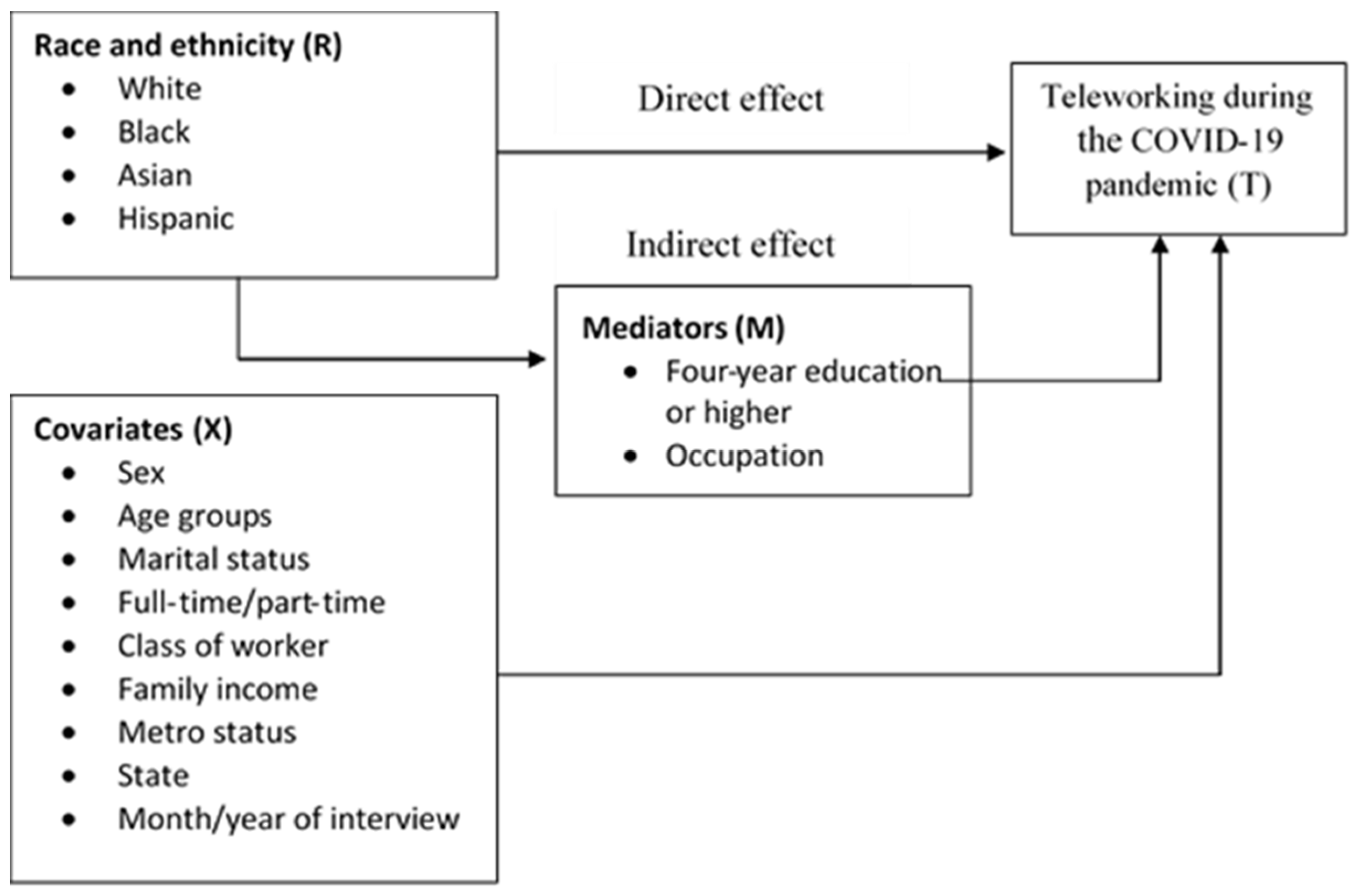
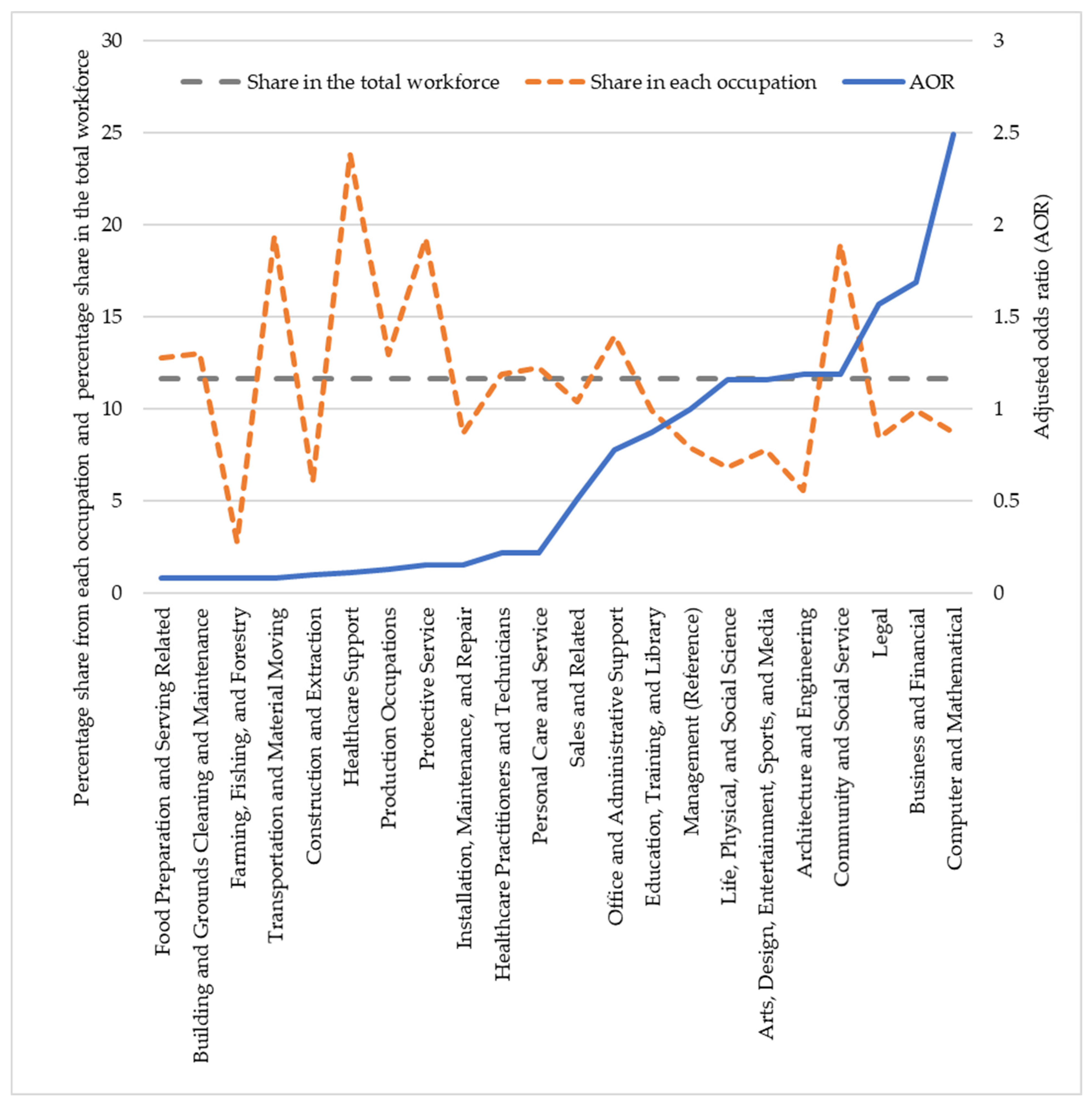
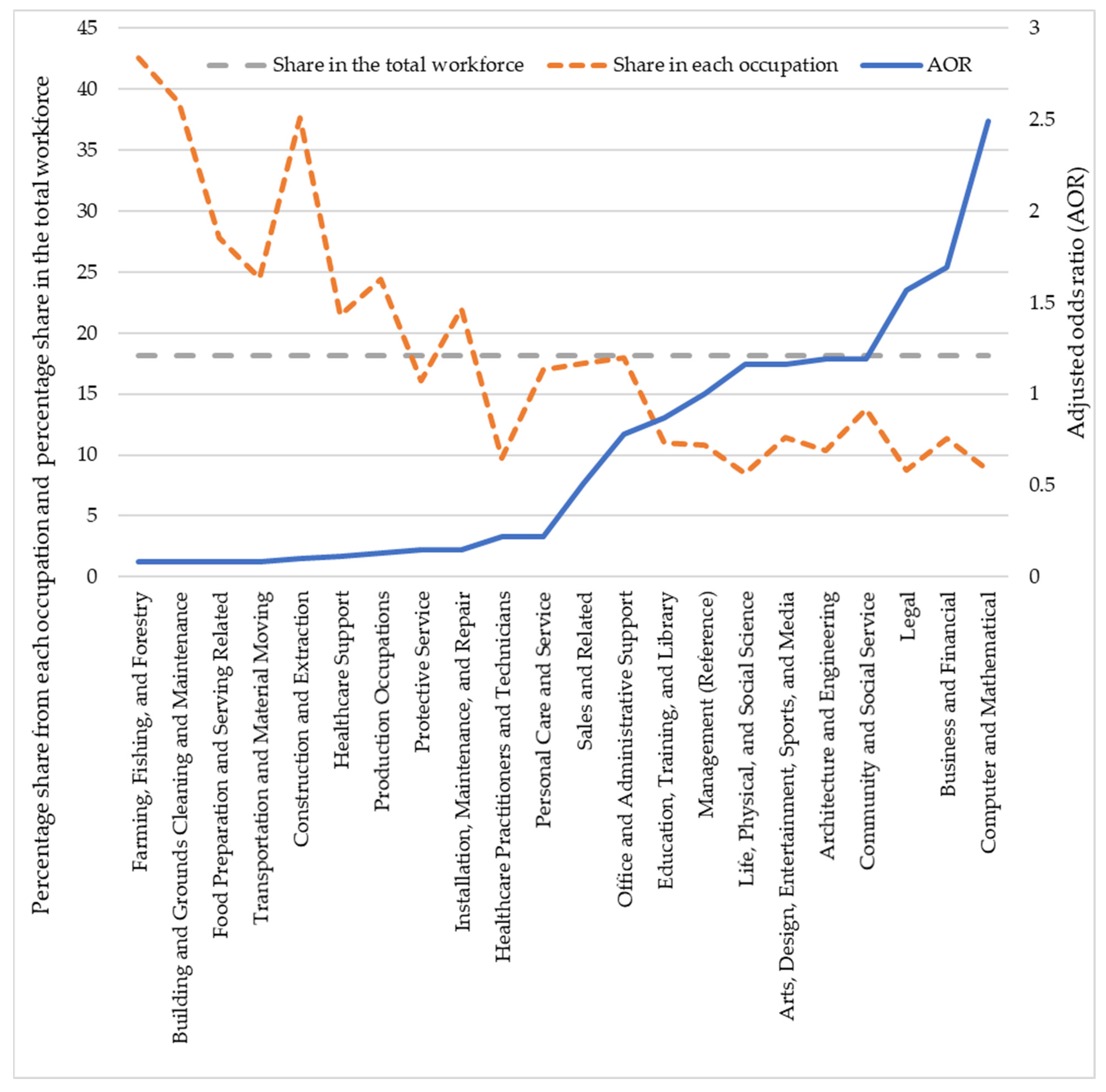
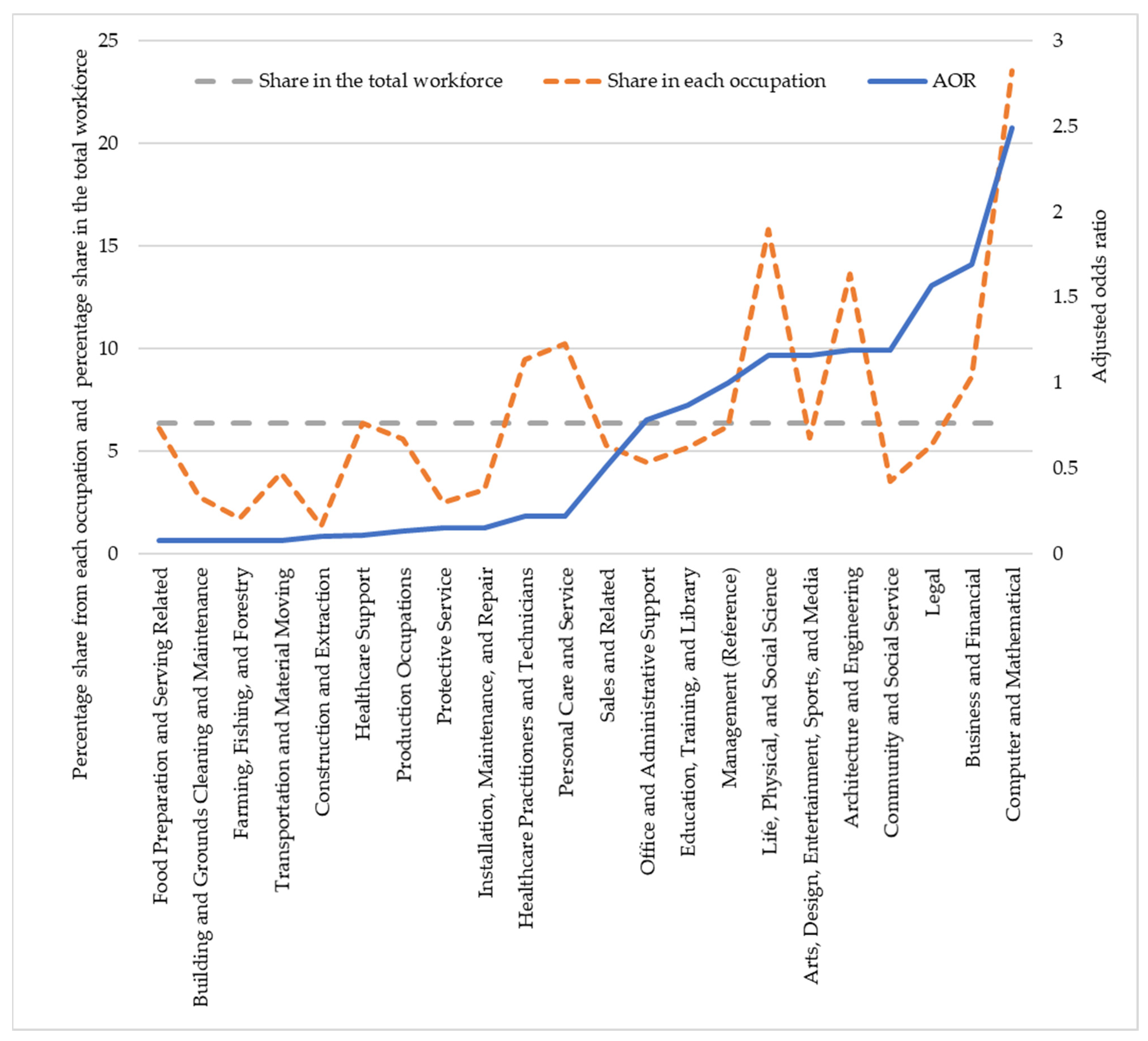
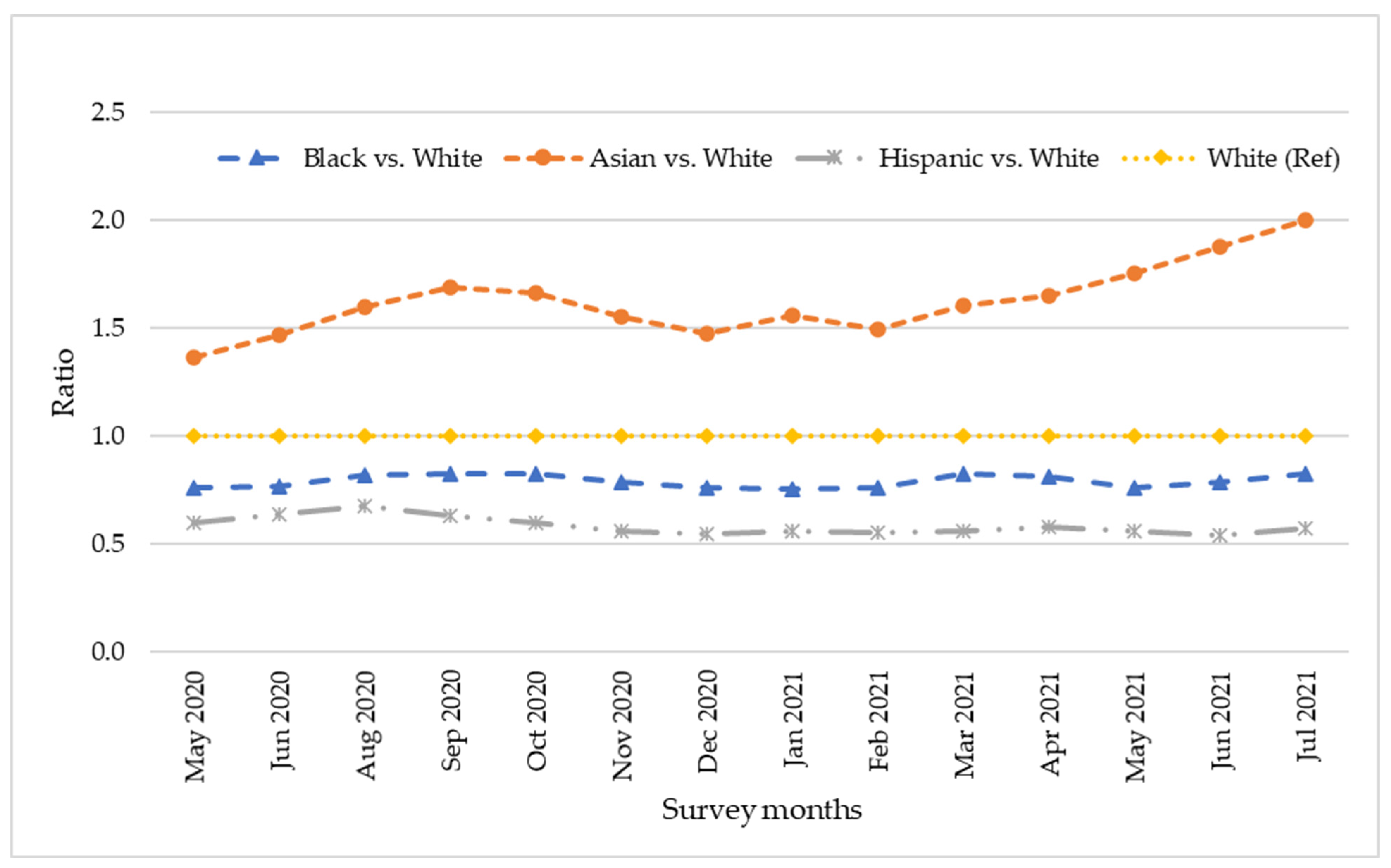
| Variables | Total | Race and Ethnicity (Race) | |||
|---|---|---|---|---|---|
| White | Black | Asian | Hispanic | ||
| Number of observations | 702,500 | 499,976 | 64,376 | 40,550 | 97,598 |
| Number of weighted observations (thousands) | 145,053 | 92,605 | 16,903 | 9270 | 26,276 |
| Percentage (weighted) | 100 | 63.8 | 11.7 | 6.4 | 18.1 |
| Outcome variable | |||||
| Teleworking because of the pandemic (%) | 22.3 | 23.7 | 18.6 | 38.3 | 13.9 |
| Mediator variables (%) | |||||
| Four-year college degree | 41.1 | 45.25 | 32.89 | 67.53 | 22.28 |
| Occupation (row %) | |||||
| Management | 75.0 | 7.9 | 6.2 | 10.9 | |
| Business and Financial | 70.1 | 9.9 | 8.7 | 11.4 | |
| Computer and Mathematical | 59.0 | 8.7 | 23.5 | 8.7 | |
| Architecture and Engineering | 70.4 | 5.5 | 13.7 | 10.4 | |
| Life, Physical, and Social Science | 68.9 | 6.8 | 15.8 | 8.5 | |
| Community and Social Service | 63.8 | 19.0 | 3.5 | 13.7 | |
| Legal | 77.5 | 8.4 | 5.3 | 8.7 | |
| Education, Training, and Library | 73.9 | 9.9 | 5.2 | 11.0 | |
| Arts, Design, Entertainment, Sports, and Media | 75.1 | 7.8 | 5.6 | 11.5 | |
| Healthcare Practitioners and Technicians | 68.9 | 11.9 | 9.4 | 9.8 | |
| Healthcare Support | 48.3 | 23.8 | 6.4 | 21.5 | |
| Protective Service | 62.2 | 19.2 | 2.5 | 16.1 | |
| Food Preparation and Serving Related | 53.3 | 12.8 | 6.1 | 27.9 | |
| Building and Grounds Cleaning and Maintenance | 45.3 | 13.0 | 2.8 | 38.9 | |
| Personal Care and Service | 60.5 | 12.3 | 10.2 | 17.0 | |
| Sales and Related | 66.8 | 10.4 | 5.3 | 17.6 | |
| Office and Administrative Support | 63.6 | 14.0 | 4.5 | 17.9 | |
| Farming, Fishing, and Forestry | 53.0 | 2.8 | 1.7 | 42.5 | |
| Construction and Extraction | 54.9 | 6.1 | 1.4 | 37.7 | |
| Installation, Maintenance, and Repair | 66.2 | 8.7 | 3.1 | 22.0 | |
| Production Occupations | 57.0 | 13.0 | 5.6 | 24.4 | |
| Transportation and Material Moving | 52.1 | 19.4 | 4.0 | 24.5 | |
| Control variables | |||||
| Male (%) | 53.2 | 53.1 | 47.1 | 53.3 | 57.2 |
| Age category (row %) | |||||
| 16–24 | 60.1 | 12.0 | 4.2 | 23.7 | |
| 25–34 | 59.1 | 13.1 | 7.3 | 20.5 | |
| 35–54 | 61.8 | 11.9 | 7.3 | 19.1 | |
| 55–64 | 71.9 | 10.3 | 5.3 | 12.5 | |
| 65+ | 77.7 | 8.7 | 4.6 | 9.0 | |
| Marital status (column %) | |||||
| Married | 67.9 | 7.9 | 7.7 | 16.6 | |
| Widowed, divorced, or separated | 66.7 | 13.7 | 3.1 | 16.5 | |
| Never married | 55.9 | 17.2 | 5.5 | 21.4 | |
| Family income | |||||
| $34,999 or less | 47.6 | 18.8 | 4.4 | 29.1 | |
| $35,000–$74,999 | 58.8 | 14.1 | 4.7 | 22.5 | |
| $75,000–$149,999 | 69.7 | 9.5 | 6.1 | 14.8 | |
| $150,000 or more (Reference) | 72.9 | 6.8 | 10.7 | 9.6 | |
| Full-time status (row %) | |||||
| Full-time | 65.4 | 10.8 | 5.6 | 18.2 | |
| Part-time | 63.4 | 11.9 | 6.6 | 18.1 | |
| Class of worker (row %) | |||||
| Public | 7.5 | 5.3 | 15.6 | 71.7 | |
| Private | 11.6 | 6.8 | 19.3 | 62.3 | |
| Self-employed | 15.2 | 5.0 | 13.4 | 66.5 | |
| Without Controlling for the Effects of Mediators | Controlling for the Effects of Mediators | |||||
|---|---|---|---|---|---|---|
| AOR | 95% CI | AOR | 95% CI | |||
| Independent variable | ||||||
| Race | ||||||
| White (Reference) | ||||||
| Black | 0.65 | 0.62 | 0.68 | 0.93 | 0.89 | 0.97 |
| Asian | 1.44 | 1.37 | 1.51 | 1.14 | 1.08 | 1.20 |
| Hispanic | 0.45 | 0.43 | 0.47 | 0.84 | 0.81 | 0.88 |
| Mediator variables | ||||||
| Four-year degree or higher | 2.43 | 2.36 | 2.50 | |||
| Occupation | ||||||
| Management (Reference) | ||||||
| Business and Financial | 1.69 | 1.62 | 1.77 | |||
| Computer and Mathematical | 2.49 | 2.35 | 2.63 | |||
| Architecture and Engineering | 1.19 | 1.11 | 1.28 | |||
| Life, Physical, and Social Science | 1.16 | 1.06 | 1.28 | |||
| Community and Social Service | 1.19 | 1.11 | 1.28 | |||
| Legal | 1.57 | 1.45 | 1.70 | |||
| Education, Training, and Library | 0.87 | 0.83 | 0.92 | |||
| Arts, Design, Entertainment, Sports, and Media | 1.16 | 1.09 | 1.25 | |||
| Healthcare Practitioners and Technicians | 0.22 | 0.21 | 0.23 | |||
| Healthcare Support | 0.11 | 0.10 | 0.12 | |||
| Protective Service | 0.15 | 0.13 | 0.16 | |||
| Food Preparation and Serving Related | 0.08 | 0.07 | 0.09 | |||
| Building and Grounds Cleaning and Maintenance | 0.08 | 0.07 | 0.09 | |||
| Personal Care and Service | 0.22 | 0.19 | 0.24 | |||
| Sales and Related | 0.51 | 0.49 | 0.53 | |||
| Office and Administrative Support | 0.78 | 0.75 | 0.82 | |||
| Farming, Fishing, and Forestry | 0.08 | 0.06 | 0.10 | |||
| Construction and Extraction | 0.10 | 0.09 | 0.11 | |||
| Installation, Maintenance, and Repair | 0.15 | 0.14 | 0.17 | |||
| Production Occupations | 0.13 | 0.12 | 0.15 | |||
| Transportation and Material Moving | 0.08 | 0.07 | 0.08 | |||
| Covariate | ||||||
| Male | 0.57 | 0.55 | 0.58 | 0.84 | 0.82 | 0.86 |
| Age category | ||||||
| 16–24 (Reference) | 1.00 | 1.00 | 1.00 | 1.00 | 1.00 | 1.00 |
| 25–34 | 3.18 | 3.01 | 3.36 | 1.82 | 1.72 | 1.92 |
| 35–54 | 2.77 | 2.62 | 2.93 | 1.73 | 1.64 | 1.83 |
| 55–64 | 2.27 | 2.14 | 2.42 | 1.56 | 1.46 | 1.65 |
| 65+ | 2.42 | 2.26 | 2.60 | 1.37 | 1.28 | 1.47 |
| Marital status | 1.00 | 1.00 | 1.00 | 1.00 | 1.00 | 1.00 |
| Married (Reference) | ||||||
| Widowed, divorced, or separated | 1.00 | 0.96 | 1.04 | 1.08 | 1.04 | 1.12 |
| Never married | 1.01 | 0.98 | 1.04 | 1.05 | 1.01 | 1.08 |
| Family income | ||||||
| $34,999 or less | 0.19 | 0.18 | 0.20 | 0.57 | 0.54 | 0.60 |
| $35,000–$74,999 | 0.26 | 0.25 | 0.27 | 0.61 | 0.59 | 0.63 |
| $75,000–$149,999 | 0.49 | 0.48 | 0.51 | 0.76 | 0.74 | 0.79 |
| $150,000 & above (Ref) | ||||||
| Full-time status | ||||||
| Part-time worker (Reference) | ||||||
| Full-time worker | 1.38 | 1.35 | 1.42 | 1.08 | 1.05 | 1.11 |
| Class of worker | ||||||
| Public (Reference) | ||||||
| Self-employed | 0.38 | 0.36 | 0.40 | 0.47 | 0.45 | 0.50 |
| Private | 0.50 | 0.48 | 0.52 | 0.76 | 0.73 | 0.78 |
| Metro status | ||||||
| Central city (Reference) | ||||||
| Unknown | 0.35 | 0.33 | 0.37 | 0.50 | 0.48 | 0.53 |
| Not in metro area | 0.19 | 0.18 | 0.20 | 0.33 | 0.31 | 0.35 |
| Outside central city | 0.62 | 0.61 | 0.64 | 0.75 | 0.72 | 0.77 |
| States (51 state dummies) | ||||||
| Period (15 month/year dummies) | ||||||
| Number of observations | 702,500 | |||||
| Race | Odds Ratio (95% Confidence Interval) | Variation Explained by Mediators (%) | ||||
|---|---|---|---|---|---|---|
| Total Effect † | Indirect Effect § | Direct Effect ‡ | Total | College Degree | Occupation | |
| White (Reference) | ||||||
| Black | 0.65 (0.62–0.68) | 0.70 (0.67–0.73) | 0.93 (0.89–0.97) | 83.1 | 25.4 | 63.7 |
| Asian | 1.44 (1.37–1.51) | 1.26 (1.21–1.32) | 1.13 (1.08–1.20) | 64.1 | 18.6 | 31.1 |
| Hispanic | 0.45 (0.43–0.47) | 0.54 (0.51–0.56) | 0.84 (0.81–0.88) | 78.1 | 28.4 | 62.8 |
Publisher’s Note: MDPI stays neutral with regard to jurisdictional claims in published maps and institutional affiliations. |
© 2022 by the author. Licensee MDPI, Basel, Switzerland. This article is an open access article distributed under the terms and conditions of the Creative Commons Attribution (CC BY) license (https://creativecommons.org/licenses/by/4.0/).
Share and Cite
Asfaw, A. Racial and Ethnic Disparities in Teleworking Due to the COVID-19 Pandemic in the United States: A Mediation Analysis. Int. J. Environ. Res. Public Health 2022, 19, 4680. https://doi.org/10.3390/ijerph19084680
Asfaw A. Racial and Ethnic Disparities in Teleworking Due to the COVID-19 Pandemic in the United States: A Mediation Analysis. International Journal of Environmental Research and Public Health. 2022; 19(8):4680. https://doi.org/10.3390/ijerph19084680
Chicago/Turabian StyleAsfaw, Abay. 2022. "Racial and Ethnic Disparities in Teleworking Due to the COVID-19 Pandemic in the United States: A Mediation Analysis" International Journal of Environmental Research and Public Health 19, no. 8: 4680. https://doi.org/10.3390/ijerph19084680
APA StyleAsfaw, A. (2022). Racial and Ethnic Disparities in Teleworking Due to the COVID-19 Pandemic in the United States: A Mediation Analysis. International Journal of Environmental Research and Public Health, 19(8), 4680. https://doi.org/10.3390/ijerph19084680






